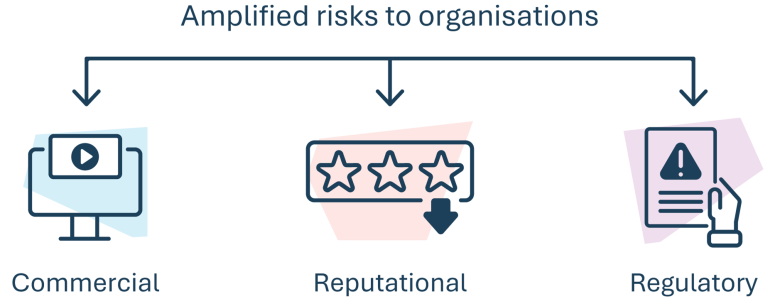AI systems have specific characteristics that amplify risks
AI systems are composed of AI models and non-AI components, with AI models playing a key role in influencing their characteristics. In this guidance, the term 'AI system' is used to include AI models when the distinction between the two is not critical. However, 'AI system' and 'AI models' will be explicitly distinguished when the difference or emphasis on both is important.
AI systems span a wide range of technical approaches. Organisations can use them for many tasks, such as helping with prediction, classification, optimisation or content generation. AI systems fall broadly into 2 types, each with different strengths and risks:
- Narrow AI systems are developed to perform a specific task. Many AI systems in use today fall into this category. These types of systems can perform well in a narrow range of tasks, potentially even better than humans, but they cannot perform any other tasks. Examples include chess engines, recommender systems, medical diagnostic systems and facial recognition systems.
- General-purpose AI (GPAI) systems are developed to handle a broad range of tasks and are therefore flexible. Their use is not limited to a specific task, so they can be more easily used for purposes their developers may not have considered. Examples include large language models and systems such as Open AI’s ChatGPT series.
Both narrow and GPAI systems are developed and operated differently from traditional software systems. These differences mean that deploying an AI system for a particular task may amplify existing risks or create new risks when compared with traditional software.
For example, in traditional software systems, developers explicitly define all the logic governing a system’s behaviour. This relies on explicit knowledge, with conscious human engagement at every stage of the software design and development process. Traditional software systems are easier for humans to control, predict and understand.
In contrast, developers of AI systems take a different approach. This often involves defining an objective and constraints, selecting a dataset, and employing a ‘machine learning algorithm’. This creates an AI model which can achieve the specified objective, and together with other non-AI components, forms an AI system that can perform a variety of tasks. While such AI systems often outperform comparable, traditional software systems, the different development approach means AI systems, in particular the AI models within them, are often less transparent, less interpretable, and more complex to test and verify. This amplifies risks and can lead to harm. This is more likely to happen in contexts where it is important to understand and explain how the output was achieved or to constrain the range of potential outputs for safety reasons.
The specific characteristics of GPAI systems, especially frontier AI, can further amplify risks and pose new risks and harms to an organisation. This is because they are highly complex and not fully understood, even by their developers. They may possess advanced capabilities that are unknown or emergent. GPAI systems have the capability to understand and use software tools and can access other systems and knowledge, enhancing their capabilities in specific deployment contexts. GPAI systems are also highly general, supporting an unlimited number of downstream planned and unplanned use cases, including deliberate and inadvertent misuse. It is impossible to evaluate all possible use cases, making pre-deployment evaluation and testing highly challenging.
For example, a GPAI chatbot system that can generate code could potentially produce malware and autonomously hack into critical systems. Similarly, a GPAI chatbot that can generate realistic images could be used to create deepfakes for impersonation and fabricating non-existent real-world events. While these systems were not designed for such specific purposes, and some guardrails can be implemented to refuse certain tasks, it is difficult to cover all potential misuses.
A proportionate approach to AI harm prevention and mitigation
As with all software, AI systems vary in the level of risk and the type of harm they pose. Some, like an algorithm that suggests reordering based on stock levels, tend to be lower risk. The potential harms are confined to a customer taking longer to receive a product or the financial impact of over- or under-ordering. Others, like a tool that prioritises job applicants for an interview process or makes financial lending decisions, have potential to create far greater harm. For instance, they may deny a suitable applicant the opportunity of a job or bank loan, or even systematically and unlawfully discriminate against a group of people.
This guidance supports a risk-based approach to managing AI systems. It does this by supporting organisations – both AI developers and AI deployers – to take proactive steps to identify risk of harms posed by the AI systems they develop, deploy, or rely on.
The implementation practices prioritise safety and the prevention, identification and mitigation of risk of harm to people. This is grounded in an approach that seeks to protect, respect and remedy human rights. By adopting this approach, AI developers and AI deployers, in turn, also prevent and mitigate the risk of harm to their own organisations.

